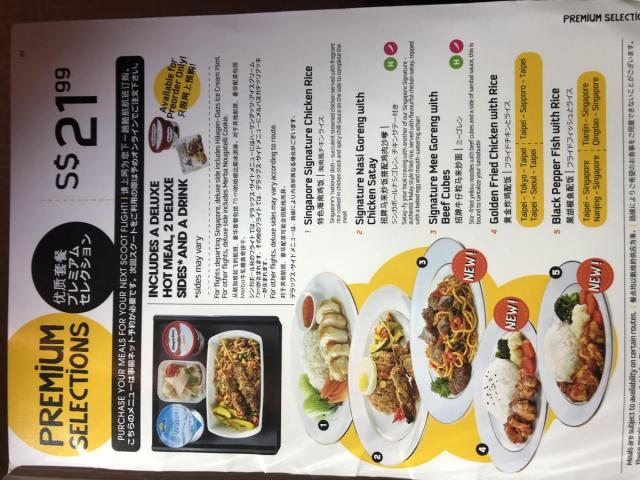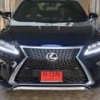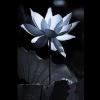Search the Community
Showing results for tags 'ShangHai'.
-
DIY holiday to China recently, with the family. Broadly, this was what we did: Day 0 - Depart Singapore to Hangzhou (Scoot Airlines), Arr. Hangzhou 2135hrs Day 1 - Hangzhou, got a driver, tour the city, including West Lake and Ling Yin Temple Day 2 - Depart from Hangzhou to Wu Zhen (water town), and then transfer to Shanghai Courtyard Marriot near Disneyland Day 3 - Shanghai Disneyland! (One full day) Day 4 - Transfer to Shanghai Marriott City Center, Walk to the Bund Day 5 - Private day tour to SuZhou Day 6 - Shanghai Free & Easy Day 7 - Home sweet Home - Shanghai to Singapore on Singapore Airlines Allow me to share in this thread my holiday. We would fly from Singapore to Hangzhou, and we were trying out ScootBiz in Scoot Airlines for the first time. Scoot is a wholly own subsidiary of Singapore Airlines, and it is their low-cost arm. When Scoot was first launched, we flew with them to Sydney! That was way back in 2012. Since then, we have flown on Scoot a few times (including Hong Kong), but this is our first time in ScootBiz. ScootBiz is Scoot Business Class? What is ScootBiz? Well, it is NOT the typical Business Class of a full service airline. It is more akin to Premium Economy. What attracted us were the seats - full learther with at least 38" of legroom, 22" of width and 6" of recline, with adjustable headrests and legrests. You also get complimentary meal and drink, but that was less important. Scoot flies from Terminal 2. Check-Lines moved quickly. You had to do self-service check in first, before dropping off your bags. That's the new trend, self-service. I didn't see any special check-in line for ScootBiz passengers, so we joined the same queue. SATS Premier Lounge Terminal 2 After clearing immigration, we headed to the SATS Premier Lounge to chill out for a while and get some food. Note that ScootBiz does not provide lounge access with the normal ticket. We used our Priority Pass cards to gain entry. Here is the entrance of the SATS Premier Lounge, which was opposite the SilverKris lounge at T2. Video of Lounge Experience A video of our lounge experience. This lounge was voted Asia-Pac lounge of the year, for Priority Pass. For a Priority Pass lounge, it is decent. In fact, a good number of airlines use this contract lounge for their Business Class passengers too. Here are YouTube video links so lounge reviews of SATS Premier Lounge in Terminal 1and SATS Premier Lounge in Terminal 3. Below is the video of SATS Premier Terminal 2. The Lounge in Terminal 2 won the Asia Pacific Lounge of the Year Awards 2017 for Priority Pass. Our credit cards provided us with Priority Pass access to Lounges, which is very nice. We could bring the entire family in, using my card and my wife's card. FLIGHT EXPERIENCE SCOOTBIZ - FlyScoot Singapore to Hangzhou Flight Number TR 188 Dep: 1635hrs, Arr: 21:35 Hangzhou Xiaoshan Airport No time zone changes We had wanted to visit Hangzhou and Shanghai. So it was great that Scoot has a direct flight. Scoot currently operates the Boeing 787-8 Dreamliner aircraft. This was our plane at the gate, its nickname was 'Bo Jio'. The 7:30 minute video below details our experience on board ScootBiz, showing you the seats and the meals. Enjoy! Food wise, ScootBiz ticket comes with food and drink. For the food package, you have to order in advance (online, when you book). I didn't realise that there were different types of meals. The most 'value-for-money' would be the Premium Meal selection, sample below. This meal comes with 2 deluxe sides and a drink. But there was no Nasi Lemak here. I selected Nasi Lemak and that was packaged with a lower value meal (no ice-cream). So, hot tip, if you want a full meal with Ice-Cream, pick from the Premium Selections! Waiting for Luggage - Scoot Crew luggage came out first Landing into Hangzhou was smooth and we got to the gates quickly. The immigration clearance was fast. What took some time was the baggage. See the video below, for pretty much the entire aircraft passengers waiting at the luggage carousel. Funny thing - the cabin crew luggage came out first! After we collected our bags, the Customs officials made all passengers put every bag through an X-ray machine, i.e. 100% check. That caused a line to form, but the overall process was orderly and didn't take too long. The video also shows snippets of the taxi ride, and the room service we had. We stayed at the Holiday Inn Hangzhou City Center, and we ordered room service for supper, as we were tired and hungry. Room Service - All the Food in the Photo for 177RMB plus 3 drinks (including beer) That concludes Day 0 - flight to Hangzhou. Day 1 - Hangzhou Today, we would hire a driver to bring us around to see the sights of Hangzhou. But before that, let me show you the narrow beds in our hotel room. Our room came with two twin beds, but when we booked on the Holiday Inn IHG website, it room clearly stated two double beds. Oh well. For the fun of it, I got two "models" to show you the breadth of the twin bed, for laughs! Breakfast The day started with a good breakfast at the Holiday Inn Buffet. Our room rate came with breakfast for two adults. The buffet supervisor allowed my two kids to eat for free. Video below shows the good food we had. Breakfast area wasn't too crowded, which was nice. Journey to West Lake (Xi Hu) Our driver picked us up from the lobby, as per the arranged time. Our ride was in a very comfortable MPV. There were many skyscrapers in Hangzhou. It looked to be a developed city. There was construction outside our hotel - driver told us that they were building new metro/underground lines. Driver's 7 Year Old Kid Studies All Day Glad that we could speak some Mandarin, and that allowed us to have interesting conversations with our driver. We did not book a guide, only driver. But as you can see and hear from the video below, our driver was more than happy to tell us about China, and his family and other interesting nuggets of life in China! West Lake, Hangzhou First stop, the famous West Lake 西湖! West Lake (Chinese: 西湖; pinyin: Xī Hú) is a freshwater lake in Hangzhou, China. There are numerous temples, pagodas, gardens, and artificial islands within the lake. Map of the West Lake in Hangzhou, China Leifeng Pagoda West Lake has influenced poets and painters throughout Chinese history for its natural beauty and historic relics, and it has also been among the most important sources of inspiration for Chinese garden designers. It was made a UNESCO World Heritage Site in 2011, described as having "influenced garden design in the rest of China as well as Japan and Korea over the centuries"and reflecting "an idealized fusion between humans and nature". (Source wiki) Below is the video of our very calm boat ride. Again, glad that we could understand some Mandarin. The boatman was most enthusiastic in telling us about Chinese culture and history. Made for some good story-telling. The scenic boat (or human powered sampan) ride took 40 minutes and cost 150 RMB. The boat can take a max of 6 pax, but I think 4 is ideal. Any more may be a bit of a squeeze. A picture of another boat going past. See that the boat is very low and we are very close to the water. You could play with the water, if you wished. Don't fall in! (Not sure if there were life jackets, maybe under the seat). After an calming boat ride, we took a walk around the waterfront. Even though we only paid for a driver, his service was excellent. He took pains to bring us around the waterfront. He brought us to see some squirrels, and then a slow walk back to the vehicle. I noticed all the electric buses and carts. Saving the environment! Even the Police Car was an electric one. Looks like the Chinese authorities were very serious in ensuring clean and fresh air around their famous Lake. Next stop was Ling Yin temple. Will continue in the next post.
-
Last time summon to SHnaghai forma project meeting. really have no idea where to go. I stay in Marvel hotel. 123 South Xizang Road 200021 Shanghai,. Dont want to travel too far from my hotel. anyplace to go? Thanks
-
Angry man rams car through the doors of a hotel lobby in Shanghai after arguing with staff about a missing laptop. Please do not try this at home. Your car is expensive, COE is expensive! 😱
- 24 replies
-
- 13
-

-
.png)
-
https://asia.nikkei.com/Spotlight/The-Big-Story/Inside-Shanghai-s-COVID-lockdown-nightmare?utm_campaign=GL_asia_daily&utm_medium=email&utm_source=NA_newsletter&utm_content=article_link&del_type=1&pub_date=20220622190000&seq_num=2&si=44594 Inside Shanghai's COVID lockdown nightmare China's zero-COVID policy devastated the commercial capital CISSY ZHOU, LAULY LI, CHENG TING-FANG and CK TAN, Nikkei staff writersJune 22, 2022 06:00 JST HONG KONG/ TAIPEI/SHANGHAI -- In late April, a few days into the quarantine of her dormitory in Shanghai, Jenny Zhang began to feel dehydrated. A senior at one of the city's top universities, she and other students on her floor had just been told they could only use communal toilets and showers on a strict rotation, and their drinking water would be severely rationed. No matter how thirsty she became, Zhang, who spoke to Nikkei Asia under a pseudonym, could only allow herself tiny sips of water from her 500 ml bottle. She tried to complain about her supervisor (an instructor who aids in managing students at Chinese colleges) not offering more water. However, her protest was opposed by her roommates, some of whom had larger water bottles and were less desperate, who argued that the supervisor was not obligated to offer Zhang special treatment. After two days, she began to experience overpowering thirst -- there was no access to even tap water in the dormitory. Students on Zhang's floor fell apart emotionally under the strain. One student said she would take a knife with her into the bathroom, threatening members of a WeChat group that she would stab anyone who tried to stop her from showering at midnight, when no one else was there. The same student also threatened to set the building on fire, saying that arson was the only way to get everyone out of the dormitory. "If anyone sets fire to the dormitory, we could die because the school would not allow us to leave the building," Zhang said. "I didn't even feel very upset at that time because, in that state, I did not want to live either. "I could feel that I was not in a healthy mental state." Residents pinned in by barriers had limited access to water during the lockdown. Couriers would bring water rations to those unable to leave their apartment blocks. © AFP/Jiji Throughout Shanghai, China's economic capital, similar stories are emerging following the official end of a strict, two-month lockdown. It was an ordeal for the inhabitants of the city that grabbed headlines around the world for its severity, perhaps the most draconian control measure recorded anywhere during the pandemic. During the lockdown, children who tested positive for COVID-19 were separated from their parents; fences were installed to restrict people's movement; pets whose owners tested positive were reportedly slaughtered by authorities; white-clad workers entered residents' apartments to spray disinfectant without consent; and at least 200 individuals are believed to have died, not due to COVID, but due to lack of access to hospitals. The outbreak was contained, if just barely. From Feb. 26 to June 15, Shanghai logged 58,098 positive cases and 588 COVID-related deaths, according to the city's Health Commission. But while the lockdown officially ended on June 1, the psychological scars have yet to heal. Wang Qing, an artist from Shanghai, told Nikkei she believes she is still suffering from post-traumatic stress disorder and has started to experience insomnia and compulsively hoard food. "I asked my therapist if it is PTSD, but he told me it is too early to conclude ... as we are still suffering from strict control," she said. Some of those who were forcibly transferred to city-run makeshift quarantine camps, known as fang cang hospitals across China -- a requirement for anyone who tested positive during the lockdown -- remain terrified every time they hear a tap on the door. Workers disinfect a locked-down residential area in Shanghai, China, on April 15. © Reuters "I've become quite sensitive after being isolated in a quarantine facility," said Mr. Xia, a college student from Shanghai who was sent to a quarantine camp during the lockdown and only gave his surname. "I am scared of a knock at the door. I dare not read news on the internet. Sometimes, I cannot help talking to myself, and my messages are full of typos when I type." Incoming storm Before the outbreak, Shanghai authorities had been proud of their COVID prevention strategy. The city had been emblematic of the success of Chinese President Xi Jinping's zero-COVID approach, which used a huge testing apparatus, along with tracking and tracing contacts and, when that failed, targeted lockdowns, to eradicate the virus within China's borders. The zero-COVID strategy appeared to be effective against the delta variant: China's reported case numbers and mortality rate were far lower than the rest of the world, while its economic growth rate had been among the highest among the world's major economies for the past two years. From late 2019, when the virus was first detected in Wuhan, until the worst outbreak began in March this year, Shanghai recorded only 392 local cases and seven deaths. But the omicron variant, which emerged in late 2021, turned out to be much more transmissible and a far greater match for zero-COVID than the delta variant. Xi's political reputation is tightly bound to the success of his zero-COVID policy, said Deng Yuwen, a former editor of China's Central Party School's official newspaper, Study Times, who now lives in the U.S. Under omicron, Deng said, the policy has become a liability for China's paramount leader. "Having fewer fatalities is a top priority for Xi, and if the epidemic results in many deaths in China, Xi may come under fire from his adversaries," Deng told Nikkei. "Xi is caught in his own trap now, as he has politicized his anti-epidemic policy. He is too proud of the achievement in combating the delta variant and thinks it demonstrates the superiority of the Chinese system over the U.S., so he is biting the bullet to stick to his zero-COVID policy." On March 2, however, a new outbreak began in the town of Meilong, 20 km south of downtown Shanghai, which reported its first positive case: a fully-vaccinated, 46-year-old woman. At around 2 a.m. on March 3, a Shanghai doctor who only gave his English name as Young was among those sent to take samples of every stair handrail and door handle along the woman's path through the residential complex. Until March, Shanghai had avoided lockdown measures due to a rigorous testing and track-and-trace policy. © AP "All the samples came back positive the next day," he told Nikkei in a recent interview. "We doctors all got the impression at the time that the area was essentially a toxic reservoir, and that we were simply waiting for the virus to break out, because there were clearly far more than one or two people infected in that complex." It was the start of a brutal three-month treadmill of work for Young and other medical workers in the city. Two days later, more than 10 people in the complex had tested positive, leaving the authorities unable to trace all their activities. And within the following week, a smattering of positive cases started to emerge across other residential complexes in Meilong. "Local authorities were obviously caught off guard, and they could only send us to test as many people as we could," Young said. Temporary testing booths were set up in areas where large numbers of people conglomerate -- industrial parks, shopping malls and wet markets. Even delivery drivers passing by would be required to take a test. As testing surged, manpower ran short and safety standards suffered. Doctors ordinarily could not be sent to take samples or do other front-line work without already having three vaccine shots themselves. But that requirement was quietly thrown out, Young said. "There is no doubt that many people got infected during the regional mass testing," Young said. "The queues were so long and people were so close to one another, and some didn't even wear a mask." When testing was done in a wet market, Young added, nearly all samples came back positive. Draconian measures After the local government's botched attempt to contain the initial spread of the virus, the central government in Beijing took over by dispatching Sun Chunlan, a vice premier who was credited for isolating the first outbreak in Wuhan in 2020. Arriving in Shanghai in early April, Sun immediately ordered local officials, including the city's top official, party Secretary Li Qiang, to "adhere unswervingly" to the zero-COVID policy. Sun went on to introduce sweeping measures that called for mass PCR tests every few days. Those testing positive -- some of them children -- were separated by force from their families, while neighbors who shared the same residential building were often hauled to makeshift quarantine centers, even if they were COVID-negative. Initially, over 25 million Shanghai residents were told to stay home for a maximum of eight days, but when daily case numbers did not recede, the government extended the quarantine order without offering an exit strategy. Food stocks run low at a supermarket in Shanghai, China, on March 17. Many residents struggled to replenish food as lockdown restrictions became stricter and shops were forced to close in the city. © AP Households soon faced diminishing food stocks, the replenishing of which was infeasible as nearly all businesses, from supermarkets to online marketplaces, ceased to function, along with crucial delivery services. Escape from Shanghai As positive cases started to climb, college students, packed into dormitories with communal showers and toilets, were bearing the brunt of the lockdown. At most Chinese universities, four students share one room with bunk beds, with one or two shared bathrooms on each floor. At the beginning of March, Zhang had heard from friends at other colleges that they had been confined to their dorms for more than a week without being permitted to take showers. It took a few weeks for these restrictions to catch up with Zhang, who had still been allowed to walk freely within her dormitory, get cafeteria takeout downstairs, shower in the public bathroom and use the communal toilets. On April 22, however, just after Zhang had completed an online job interview, she was ordered to return to her dormitory immediately and remain indoors as a student in her building had tested positive. Residents line up for compulsory COVID-19 tests during Shanghai's lockdown on May 19. © Reuters "We were actually shocked," Zhang told Nikkei, "because none of us had been allowed out of the building for the past few weeks. Where did the virus come from?" For three weeks after that, Zhang and her dorm mates were stuck inside their building, with strictly rationed amenities and limited access to food and water. Zhang started to consider leaving Shanghai in early May as she felt increasingly traumatized. Getting a train ticket home was easy; leaving was not. To even board a train, Zhang had to submit an application to her university along with a copy of her train ticket. She also had to present the university with a letter from her hometown's local government confirming she was permitted to return home. Further, she had to present a copy of the most challenging document to get hold of: a government-issued pass certificate for the cab she intended to take. After completing the painstaking process, Zhang was set to head off by train in mid-May. Flying was out of the question as most flights out of Shanghai were canceled during the lockdown. In April, 1,735 flights departed from Pudong International Airport, down from 6,017 in March, according to Flightradar24. The night before her departure, Zhang was wracked with nerves. She heard news that the rule in her district was only empty cars could traverse roads; no passengers were allowed in vehicles, even if the driver had a city-issued pass certificate. Some of her classmates aboard a bus had to duck out of sight at a police-monitored checkpoint. "I was so scared that I had an emotional breakdown," Zhang said. "After all these painstaking preparations, I am still not allowed to leave?" At midnight, a few hours before Zhang's scheduled departure, one student in a WeChat group was cycling to the train station -- 28 km away from his college -- on a shared bike. The student was stopped halfway by police, and he was asked to return to his university as he failed to show the police approval from his hometown permitting his return. As a result, he tried a path suggested by other students but again came across a police officer stationed at an intersection. Thankfully, the officer was dozing, so the student could quietly sneak by. Despite all the horror stories, Zhang's departure was "surprisingly smooth." She was collected by a taxi in the morning and, apart from being stopped at one checkpoint, made it to the train station. After so many complications, Zhang felt lucky she had made it out. Zhang, who had hoped to find a job in Shanghai after growing deeply fond of the metropolis, has started a new life in Guangzhou. "I feel like a scumbag," she said, "who finally had the strength to exit my relationship with my abusive partner, who had repeatedly beaten me." Supply chain torment Shanghai and its surrounding areas are key to the world's tech supply chain. Taking Apple suppliers alone, more than half of the world's top 200 have manufacturing facilities in the region, according to a Nikkei Asia analysis. Shanghai not only hosts the most important production site for MacBooks but also a significant iPhone manufacturing base. The city holds a Tesla Gigafactory and has evolved into an ecosystem for a range of vital electronic components used by global tech giants such as Dell and HP, from chip manufacturing and assembly to printed circuit boards, acoustic parts and power components. An aerial view of the Tesla Shanghai Gigafactory. Tesla is one of many tech companies that rely on Greater Shanghai as a base for key parts. © Getty Images "The supply chain is obviously also impacted [by the lockdown]," Jensen Huang, CEO and founder of U.S.-based tech company Nvidia, told Nikkei and other media outlets in a recent interview. "In the case of China, the lockdowns affect people's ability to manufacture, and so that affects the supply chain, which overlaid on top of an existing supply chain disruption is quite extraordinary." China's status as a supply chain hub is being severely tested by Beijing's zero-COVID policy. The management and well-being of tens of thousands of workers isolated in one place became a great challenge for many suppliers during the strict lockdowns in the Greater Shanghai area, which includes the nearby cities of Kunshan and Suzhou in Jiangsu Province and is one of the world's biggest electronics manufacturing hubs. Tony Tseng, an Apple supply executive who asked to speak under a pseudonym, told Nikkei: "The most terrifying thing about this omicron wave isn't the virus but the fearsome atmosphere spreading among our employees and workers." Tseng's factory in Shanghai, which houses more than 25,000 workers, went under lockdown in early April. More than 40 employees showed signs of mental disorder. He added that one of his workers even started to claim he was Xi Jinping, breaking equipment in the factory and becoming aggressive toward nurses. The mandatory COVID tests arranged by local authorities were another mental and physical challenge. "We had more than 50% of employees being sent to [city-run quarantine camps] during the lockdown," Tseng said. "Some of them even entered the facility twice. It was an extremely traumatic experience." The supply executive added that since Shanghai reopened several of his colleagues have requested therapy. Maintaining food supplies for tens of thousands of people was another headache. "There were times it was so close that our daily hot meals were almost being cut off due to the delayed delivery," Tseng said. "We arranged big packs of snacks like bread, cakes, long-life milk, instant noodles and canned food to make sure everyone did not starve. Shanghai's Lujiazui financial district became a ghost town during the lockdown imposed in April and May. Only government workers in protective suits were seen in the district's usually busy streets. © Reuters "Restart[ing] production is not our No. 1 priority now, the mental health of our employees is. ... We have to take care of them, and the bottom line is that we can't have anyone die because of this pressure. "The costs of employee meals are three times higher than before the lockdown, and every day we have an average of 300 workers resigning since the lockdown was lifted, which I could totally relate to. In terms of production output, the entire April-to-June quarter was basically in vain." An executive from another Apple supplier, whose facility in Shanghai employs around 10,000 workers, told Nikkei that about 10% of their staff who did not live in on-site dorms were prohibited from leaving the factory grounds when the lockdown was announced without warning; they were not allowed to go home to prepare or collect personal belongings. According to the executive, many believed the surprise lockdown would only last a few days. Workers who were not allowed to go home were forced to stay overnight in the factory: "[Employees] had to sleep on the hard floor of the plant ... That's really not something normal people could take," he said, adding that supplies such as towels and blankets were severely limited. Shanghai's lockdown was part of President Xi Jinping's zero-COVID policy, which aims to keep case numbers in China low by imposing harsh, concentrated lockdowns on areas with high numbers of infections. © Getty Images "If you complain about all the inconvenience to the authorities, things could become even worse," the executive told Nikkei. "You have to be careful or the officials might roll out even tougher rules and reviews against your plant." The suppliers that Nikkei talked to all said they have geared up their production diversification plans under requests from their clients because of recent lockdowns in Greater Shanghai. Said Tseng: "Diversification is a long-term solution but it cannot solve the problems we are facing at the moment. We are pretty sure the lockdowns will happen again somewhere. ... It's a supply chain disruption that the entire industry has to face together." Documenting the devastation Given the restrictions on water, food, mobility and medical attention, not to mention the overzealous implementation by local officials, it was not surprising that the policies led to many preventable deaths. Judging by social media posts that could not be verified, the two most common causes were being denied needed medical attention and suicide. On April 14, after seeing news that a local nurse, Zhou Shengni, had died after being refused treatment for asthma at her own hospital, a Shanghai startup executive began to compile a list of deaths due to restrictions since the lockdown. He gave his name as Mr. Wang and said he was shocked into action by Zhou's story. Many hospitals in Shanghai would only allow patients to enter if they could show proof of a negative COVID-19 test. © AP Wang's list was mainly based on social media reports. Although he didn't verify each post himself, Wang marked all the key information in each post, including ages and addresses. The list spread like wildfire after Wang posted it on his WeChat account. Within five hours, the post had gained nearly 3 million views. About 10 people messaged Wang, saying their relatives or friends had also died due to the coronavirus restrictions in Shanghai. Like many viral posts on Chinese social media, the list was censored by WeChat after five hours. Wang estimates that the post would have received more than 10 million views had it not been censored, as people were reposting it and noting their strong dissatisfaction with the inhumane restrictions. After the list was censored, some unknown social media user uploaded the list to a cloud spreadsheet collaboration platform so that anyone with the link could contribute. The list is incomplete but so far contains evidence of more than 200 non-COVID deaths in Shanghai, mostly due to the draconian controls. The names on Wang's list are not included in Shanghai's official number of 588 COVID-related deaths since the lockdown. In the list Wang started, names include Qian Wenxiong, a health official who died by suicide, Chen Shunping, a musician who killed himself after being refused admission by two hospitals over acute abdominal pain and an unnamed 67-year-old man who died over no access to hemodialysis after being locked in at home for days. One day after the non-COVID death list was censored, Wang received two calls from someone claiming to be a police officer. The man asked Wang if the list was compiled by him and whether he had started the cloud spreadsheet, too. Makeshift barricades were erected throughout Shanghai to control movements in and out of residential areas. © Getty Images Wang admitted to making the initial list on WeChat but denied having anything to do with the cloud spreadsheet. "I don't know who made that spreadsheet," he told Nikkei, "but I am happy that somebody did it and took the torch from me." As of publication, Wang remains safe, but he says the true death toll from the lockdown may never be known. “It is really hard for civil society to get an accurate death toll due to covid restrictions, unless the authorities release it, or we have to check with each hospital, which is very difficult too,” he said. Pointing the finger The apparent failures of the lockdown have made China's zero-COVID policy the target of unprecedented public anger. There was a smattering of short-lived protests: Residents took to banging pans and shouting from the windows of their homes to protest the government's inadequate food allocations. Someone also produced banners printed with the list initiated by Wang, along with slogans such as "Oppose Infinite Lockdown" and "People Are Dying." The banners were swiftly taken down. Powerful decision-makers so far have avoided blame. Instead, lower-level officials have been scapegoated. At least 50 low-ranking officials at the district and county levels have been relieved of their duties, according to the website of the city's Commission for Discipline Inspection, the Communist Party's internal police. They were punished for various offences, including delivering expired food, for local virus outbreaks, and even one case where five officials in Putuo District were fired following a blunder at a state-run nursing home where a conscious resident was mistakenly sent to a funeral parlor. Shanghai residents said that they blame excesses on the overzealous interpretation of rules by local officials. “At the end of the day people are not afraid of the virus, people are afraid of these strange policies, authorities and government. People are afraid of being caught with the virus, but not because the virus will kill them. If you contract Covid, that means your family, your neighbors and even the whole building need to be quarantined again," Keith Yao, a longtime Shanghai resident and a director of an exhibition business, said. Neither vice premier Sun nor Secretary Li, the city's top official who was widely seen as a contender for higher office in Beijing, have accepted any responsibility for the outbreak, or the chaos caused by the lockdown. Far from it, Li claimed victory. "Our city is fast recovering," Li told grassroot leaders on June 1, the day when the lockdown ended. "This achievement was not easy, impossible without the continuous struggle of the grassroot comrades and the support of the city's residents at large." Residents wearing protective masks stand behind a makeshift fence in Shanghai on June 6. There were a few protests against the restrictions, but those speaking out faced stricter restrictions or even detention. © Reuters However, analysts of Chinese politics say that Li and the rest of the Shanghai leadership have suffered politically from the chaos of the lockdown. "By extension, Li's reputation as a leader has been dented," said Dali L. Yang, a professor who studies the politics of China's development and governance at the University of Chicago. "The question is by how much." Yang said the matter may affect promotion prospects for Li at the upcoming 20th Communist Party Congress later this year. But few hold out much hope or change. "In China, if you resist, you are basically an individual against the entire regime and will likely be detained," said Deng, the former editor of the Central Party School's newspaper now living in the U.S. "And organizing others to resist can be even more costly. Especially during an epidemic, any protest needs to be organized online, which is impossible as internet surveillance is ubiquitous in China." The closest thing to a public apology came on April 9 when a deputy mayor acknowledged the government's constraints but steered clear of blaming the zero-tolerance policy. "A lot of our work has not been enough, and there's still a big gap from everyone's expectations," Zong Ming, deputy mayor of Shanghai, said on April 9. "We will do our best to improve." Additional reporting by Marrian Zhou in New York.
-
Epic. http://gizmodo.com/5304233/entire-new-13+story-building-tips-over-in-shanghai/
-
much closer to home this time. SINGAPORE - Passengers on a Singapore Airlines (SIA) flight bound for Shanghai on Saturday had a bit of a scare when both engines experienced a temporary loss of power amid bad weather. The incident occurred at 39,000 ft about 3.5 hours after Flight SQ836, operated by an Airbus A330-300, left Changi Airport. "Both engines experienced a temporary loss of power and the pilots followed operational procedures to restore normal operation of the engines" said the airline's spokesman. The flight with 182 passengers and 12 crew on board continued to Shanghai and touched down safely at 10.56pm local time, he added. The engines were thoroughly inspected and tested upon arrival in Shanghai with no anomalies detected. SIA is reviewing the incident with engine maker, Rolls-Royce and Airbus.
- 124 replies
-
- 1
-

-
- sia
- power loss
-
(and 7 more)
Tagged with:
-
At least 35 people (mostly students) were killed in a stampede along the historic Bund area as huge crowds of revelers gathered to watch the countdown to the New Year, the Shanghai government said today The stampede, which occurred about 11:35pm in Chen Yi Square across from the Peace Hotel, left 35 people dead and 48 injured, the city government information office said on its Weibo site. http://www.china.org.cn/china/2015-01/01/content_34455303.htm 乐 极 生 悲
-
http://www.chinese-luxury.com/gallery/20130422/27565_44.html :wub:
-
Hi, I am married with a wife, no kid. my company are sending me to China (almost certain as nobody else can go as I am one of the partner for this company) for at least 1-2 year. problem is my wife has her own career which pay her quite well and she is almost certain does not want to separate with me for too long. If I am asking her to give up her career and join me in China - she will have to give up everything she built up in her company and restart, even might have to restart again when she come back to Singapore. If she remained in Singapore and I will be in China, this is something she do not want to it to happen. what should I do?? If almost certain I will need to be in China. Should I ? 1)ask her to follow me China and leave her career? 2)ask her to remain in Singapore. I know final decision still within us but I just hope someone can share their experience or idea as I am totally loss now... Thanks
-

Italian firm Icona will make its U.K. debut at Salon Prive
PetrolHead posted a blog entry in MyAutoBlog
Here is a new supercar maker to take note of - Icona from Italy. Well they are not exactly new, having been around since 2010, with the launch of the electric concept car - the Fuselage. The Fuselage was a finalist at the 27th Festival Automobile International in Paris in the World's Most Beautiful Concept Car competition. The Italian firm was founded by Italian members and is led by an Italian director. The headquarters for the automaker is in Shanghai while the car is made in Italy. Icona has recently developed their second car - the pretty wicked looking Vulcano - which will make its U.K. debut in September at Salon Prive. The Vulcano coupe seats two and was unveiled in Shanghai earlier this year. The one-off is powered by a V12 Hybrid reaching up to 950bhp, capable of a top speed of 350km/h and a quick century sprint timing of nine seconds. The Vulcano was engineered by world famous former Scuderia Ferrari technical director Claudio Lombardi. Sales Director, David Bagley commented, "Icona is a very exciting new brand and we are delighted that it has chosen Salon Priv -
As time goes by, China seems to be getting more lucrative when it comes to the automotive market. There are many global automakers out there that have seen huge sales of their car lineups in the country. The German automaker BMW, for example, managed to sell no less than 330,000 units of cars in China last year. In comparison, its rival automaker, Audi, sold at least 400,000 units within the same time period. So, it seems rational for another automaker to come and join the business. In this case, it's the US automaker Cadillac, which is a division that belongs to General Motors (GM). GM has now made clear its intention of building a plant in China after acquiring the signature from the National Development and Reform Commission in the country. The signature means approval for GM to build its plant which is estimated to cost $1.3 billion (S$1.6 billion) in total. The plan is that GM will start establishing the plant in June 2013. In terms of production capacity, the plant is expected to deliver 150,000 units per year. The plant is to be situated at the Jinqiao zone in Shanghai. This factory building approval seems critical for Cadillac as the company has already avoided being forced to pay 25 percent of import tariffs. This is possible thanks to Cadillac's decision to switch its XTS sedan production to China. Bob Socia, President GM China, even happened to comment that it was an imaginable probability that the Cadillacs manufactured in China could be sold in the United States of America. Well, it seems that globalisation has entered a whole brand new era. It's brave and yet, it's also strange at the same time.
-
Claimed to be the fastest street car Ferrari has ever produced so far, there's almost nothing to criticise regarding the LaFerrari. From its eye catching styling cues to its mild hybrid powertrain featuring 963bhp, I don't see anything this car is lacking of. Instead of sporting a single focal point, as in the case with most other cars, there isn't any on the LaFerrari. Well, the only one perhaps, is its canopy like roof that seems quite interesting to me. In short, this is one dream Italian prancing horse built in Maranello. Some other models such as the Ferrari 458 Spider and the Ferrari FF were also built in the aforementioned Italian city. The Ferrari LaFerrari has been detailed perfectly by means of carbon fibre material. As far as design is concerned, it seems to me that the only thing which can outdo the design is the car's stunning performance with a top speed of 350km/h and an ability to accelerate from 0-100km/h in just less than 3 seconds. As mentioned earlier, the LaFerrari is a hybrid model which means it carries a V12 petrol engine along with an electric motor. The Italian automaker is planning to sell no more than 499 units of its latest supercar - which happens to be the company's first hybrid prancing horse. Well, it seems quite a good idea to bring the model to China - through the 2013 Shanghai Motor Show - as the country may be able to 'swallow' all units of the model based on financial ability. That also leads to figuring out the actual number of units that will actually see the land of the Far East. That said, I believe that there'll be some for the Middle East to 'consume' as well. Regarding the price, as far as I know, Ferrari will stick a price tag ranging somewhere around
-
- new model
- new technology
- (and 14 more)
-
We know that the MPV market in China is dominated by commercial vehicles instead of passenger cars. Honda sees this, too, which is why it's developed the Honda Concept M. Sketched by Honda designers at Honda's Automobile R&D Centre in the land of the rising sun, the Honda Concept M has been developed mainly for the Chinese market and has now been officially launched in the 2013 Shanghai Auto Show. According to Honda, the Concept M is a next generation MPV that will offer an added value by realising a spacious as well as comfortable cabin. The Honda Concept M looks sporty and futuristic in front. It sports a pair of slanted headlamps and a large front grille that extends to the front bumper and is surrounded by chrome accents. A sporty design can also be sensed from the design of the front bumper. On its sides, the body curves and sloping roofline make the car look dynamic. In addition to that, its side mirrors sport a futuristic slim design. Last but not least, the sharp edges on the rims emphasise the sportiness of the car even further. At the rear, the car looks luxurious with its combination taillights that are likely to feature LED bulbs. Honda has also equipped the car with a rear roof spoiler. Just like the front fascia, the rear also gets treated with chrome accents. The Japanese automaker is planning to release the car next year. Unfortunately, aside from that, Honda is currently pretty tight lipped regarding the details of the Honda Concept M. As for now, you may want to watch the video below to see the car in action.
-
Just a couple of weeks ago, Mitsubishi teased us with images of its new compact sedan. It came with four doors and it seemed to be only as big as, if not smaller than, the Chevrolet Sonic or the Renault Symbol. However, the wait is over and now, we've finally got to see what the latest compact sedan from Mitsubishi will actually look like. Planned to bow at the 2013 Shanghai Auto Show, official images of the car have spread across the World Wide Web. The car is to be called the G4 Concept at the automotive exhibition in China that will take place later this April. According to the Japanese automaker where the car comes from, the Mitsubishi G4 Concept will feature high clarity diamond headlamps and front grille that are cut brilliantly. In addition to that, Mitsubishi also claims that the rear combination taillights will have a sharp impression left behind as the car heads away out of sight. Judging from the images, the exterior of the Mitsubishi G4 Concept looks sporty somehow with the sporty front bumper design, side skirts, and a sporty rear bumper. There's also a spoiler trunk lid featuring a highly mounted (seemingly LED) brake lamp. The automaker is planning to sell this model globally so we should also see one on our shores when it's finally marketed. If you're curious about what it has under its hood, well, the model will feature a MIVEC engine with a displacement capacity of 1,200cc. It will be mated to a CVT transmission and the body of the car will be equipped with RISE (Reinforced Impact Safety Evolution) technology. Well, it's up to Mitsubishi to claim that the car will leave a sharp impression. Yet, from what we've seen on the images, there's just too much blue on it. The headlamps feature a blue colour and so do the front grille, front fog lamps, and even the rear combination taillights. Honestly, it looks kind of tacky.
- 5 comments
-
- new model
- new technology
- (and 15 more)
-
[extract] After dealing in the Chinese automotive market for 30 years, the German automaker Volkswagen (VW) is enjoying a sustainable growth. As a matter of fact, it has been determined to have invested an amazing figure, totaling
-
- motoring
- other news
-
(and 24 more)
Tagged with:
- motoring
- other news
- events
- china
- europe
- germany
- volkswagen
- vw
- german
- automaker
- german automaker
- investment
- china investment
- vw china investment
- faw volkswagen
- shanghai volkswagen
- shanghai
- electric vehicles
- electric
- electrified
- crossblue
- coupe
- concept
- crossblue coupe
- crossblue coupe concept
- vw coupe concept
-

Mercedes reveals the GLA Concept before Shanghai Auto Show
RchLuvSlly posted a blog entry in MyAutoBlog
Although the 2013 Shanghai Auto Show won't take place until 20th April 2013, the premium German automaker Mercedes-Benz seems impatient to reveal its latest compact crossover concept. Mercedes calls it the GLA Concept. Looking like a taller A-Class, the concept is based on the German automaker's new MFA platform. With that being said, it's likely that Mercedes will price the car close to the price of the B-Class. Besides, it will go below the GLK lineups. The interior of the German compact crossover concept is dominated by brown-silver colour combination. The designs of the dashboard and centre console are quite futuristic, too, with some blue illumination. The GLA Concept will have a total power output of 211bhp, with a probable AMG version. The AMG version is expected to feature a total power output of up to 354bhp, thanks to a 2.0-litre four-cylinder turbocharged engine. This latest compact crossover concept from Mercedes-Benz will come with an FWD drivetrain and will be available with either a diesel or a petrol engine. Unfortunately, though, it seems that you won't be able to buy this car at least until the 2013 Frankfurt Motor Show as the production version isn't due until September.-
- new model
- new technology
- (and 17 more)
-
Acura, the luxury division under the Japanese automaker Honda, has released an image of a new concept vehicle prior to the 2013 Shanghai Auto Show. From the image released, the concept vehicle is seemingly a crossover. Acura had mentioned that the concept will debut for the first time in the world at the automotive exhibition that will take place later this month in Shanghai, China. Unfortunately, apart from that and the image, the automaker has yet to reveal any other details, such as engine specifications and interior features. The concept is likely to create a new market segment, considering Acura has recently launched the 2013 all new RDX and the 2014 MDX. Judging from the tyre sizes in proportion to the car's body in the image, it seems that this new concept vehicle from Acura will be a compact crossover. If so, it'll potentially compete against the BMW X1, the Audi Q3, the Mercedes-Benz GLA-Class, and the Lincoln MKC, the latter two of which are going into production soon. It seems that Acura won't be the only one previewing a new concept vehicle as Honda will also do the same thing. The model that Honda will likely preview is a redesign of the Honda Odyssey. Yes, although the North American version (redesigned) of the model had just recently been revealed in the 2013 New York Auto Show, Honda has actually been selling the global version since 2008. Therefore, it seems wise for the model to see a redesign of its global version soon.
-
How come nearly 3000 'Chu Pa Chieh' decendants landed in Shanghai River ..... Some believe that those pigs got some kind of virus and died. The farmer then dump them into the river. hmmmmmm............ can forget eating roasted pork in Shanghai for the time being while holidaying there ...... From Yahoo : Thousands of dead pigs found in Shanghai river Nearly 3,000 dead pigs have been found floating in Shanghai's main waterway, the Chinese city's government said Monday as residents expressed fears over possible contamination of drinking water. Shanghai's water bureau said over the last two days workers had fished 2,813 pigs out of the Huangpu river, which cuts through the commercial hub and creates its waterfront Bund district. In the southwestern district of Songjiang Monday, workers used long-handled rakes to pull the bloated animal carcasses, which were turning from pink to grey, out of the water onto a small boat, an AFP photographer witnessed. The stench of rotting pork hung over the river as workers dumped the partially disintegrating bodies into the hold. The dead pigs included both piglets and adults weighing hundreds of pounds, the Shanghai city government said. link: http://sg.news.yahoo.com/plague-pigs-shang...-045722657.html
-
Previewed by the Audi A3 Concept at the 2011 Geneva Motor Show, the production version of the A3 sedan will be making its global debut at the upcoming 2013 Shanghai Auto Show come April. Audi CEO, Rupert Stadler, commented that the new model will be an important derivative which will stimulate additional growth, especially in China and the U.S. Perhaps this explains the sedan's debut in Shanghai. The A3 sedan will be a direct competitor to the Mercedes CLA. The A3 sedan will be built at the country of launch. Chinese press reports that the A3 sedan will be assembled at the FAW-VW joint venture that also manufactures a variety of Audi models. However, I believe there will be other manufacturing sites around the world. Measuring about 4,400mm long by 1,840mm wide by 1,390mm tall, the baby sedan will be built upon VW's MQB platform. The engine lineup is expected to be carried over from the 2013 A3 hatchback. This means a range of TFSI petrol power plants ranging from 1.4-litre to 2.0-litre as well as 1.6-litre and 2.0-litre TDI options. S-Tronic transmission is available as an option on all models. Note: Photo shows A3 Concept
-
Anyone out there like me had bought the Groupon $0 shanghai trip but had already went and came back? What's the experience? Did you stay in the 4star hotels which stated in the groupon? And will the tour guide be pushing you in purchasing many things? Please have some feedback.Thanks. Will be going end of this month. Thanks :)
-
If not who you want to see win it? 8mins to start of race now.....
-
How good does it this sound? That is of course a rhetorical question. Different rules must apply in China, as, if I did that in the UK I'd have plod knocking on my door in double-quick time! In particular it is noticeable how fast the gear changes are. They are much, much faster than a standard 599, which in itself isn't bad for a single clutch gearbox. via: autoviva













